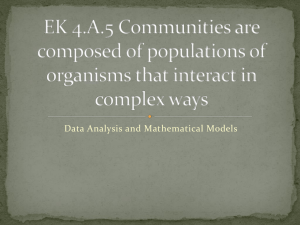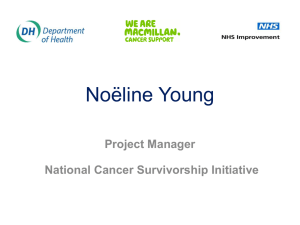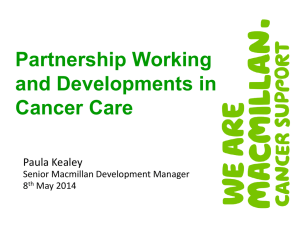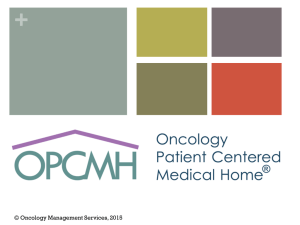Survivorship Care Plans
advertisement
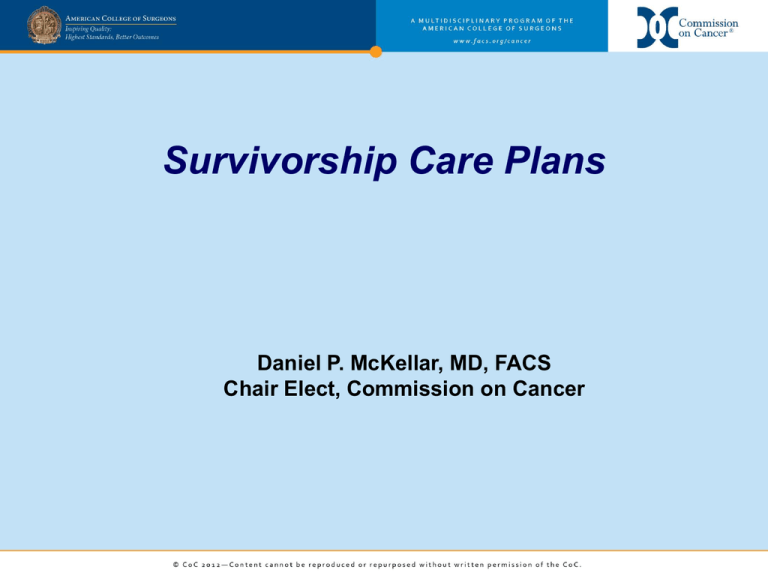
Survivorship Care Plans Daniel P. McKellar, MD, FACS Chair Elect, Commission on Cancer Survivorship Care Plans • Introduction to the Commission on Cancer • Overview of New COC Standard On Survivorship Care Plans • Who, what, why, and how of care plans • Sample survivorship care plans and resources Commission on Cancer: Our Mission The CoC is a consortium of professional organizations dedicated to improving survival and quality of life for cancer patients through standard-setting, prevention, research, education, and the monitoring of comprehensive quality care. Commission on Cancer Membership 49 professional organizations • Administrative: American College of Oncology Administrators, Association of Cancer Executives, Association of Community Cancer Centers, American Hospital Association, National Consortium of Breast Centers • Advocacy/Patient Based: American Cancer Society, Cancer Support Community, LIVESTRONG, National Coalition for Cancer Survivorship • Allied Health: American Academy of Hospice and Palliative Medicine, Academy of Nutrition and Dietetics, Oncology Nutrition Dietetic Practice Group, American Psychosocial Oncology Society, Association of Oncology Social Work, National Society of Genetic Counselors, Oncology Nursing Society, • Clinical: American Academy of Pediatrics, American College of Obstetricians & Gynecologists, American College of Physicians, American College of Radiology, American College of Surgeons Oncology Group, American College of Surgeons Resident & Associate Society, American College of Surgeons Young Fellows Association, American Head & Neck Society, American Pediatric Surgical Association, American Radium Society, American Society of Breast Surgeons, American Society of Clinical Oncology, American Society of Colon & Rectal Surgeons, American Society of Radiation Oncology, American Urological Association, College of American Pathologists, Society of Gynecologic Oncologists, Society of Nuclear Medicine, Society of Surgical Oncology, Society of Thoracic Surgeons Commission on Cancer Membership 49 professional organizations • Government: Centers for Disease Control & Prevention, Department of Defense, Department of Veterans Affairs, National Cancer Institute, Applied Research Program, National Cancer Institute SEER Program • Registry: National Cancer Registrars Association, North American Association of Central Cancer Registries • Research/Education: American Association for Cancer Education, The Institute for Palliative Medicine at San Diego Hospice, American Joint Committee on Cancer, Association of American Cancer Institutes, National Comprehensive Cancer Network, National Surgical Adjuvant Breast & Bowel Project CoC Objectives • Establish standards to ensure quality, multidisciplinary, and comprehensive cancer care delivery in healthcare settings • Conduct surveys in healthcare settings to assess compliance with those standards • Collect and use data to monitor treatment patterns and outcomes and enhance cancer control and clinical surveillance activities • Provide access to data for cancer programs to use for quality improvement, administrative purposes, and for research • Provide resources to cancer programs and provide effective educational interventions to improve cancer prevention, early detection, care delivery, and outcomes in healthcare settings Historical Timeline of the COC • 1930 – Standards for cancer clinics developed • 1933 – Initial group of 140 facilities accredited • 2012 – Currently accredit over 1500 facilities in all 50 states 1600 1509 1429 1400 1405 1200 1995 2001 2011 Cancer Programs in U.S. Hospitals Hospitals with accredited programs 30% Treated elsewhere 29% Hospitals without accredited programs 70% General medical/surgical facilities Including Puerto Rico=~5000 *Cancer Facts and Figures, American Cancer Society Diagnosed and treated in accredited programs 71% Estimated new cancer patients in 2011: 1,596,670* 2012 New Cancer Program Standards The Future of Quality Cancer Care Survivorship Care Plan • Why do we need this new standard? – 12 Million Americans “Living” with cancer – 1 in 10 American Households have at least one person who has been diagnosed with cancer in the last 5 years – Cancer is a lifelong diagnosis with lasting effects • Often emotional, physical, psychosocial effects Why do we need survivorship care plans and treatment summaries? Why do we need survivorship care plans and treatment summaries? Why do we need survivorship care plans and treatment summaries? Why do we need survivorship care plans and treatment summaries? How comfortable the primary care physician is managing late health effects and transition issues How often the primary care physician received treatment summaries of their patients with cancer Survivorship Care Plans “The challenge in overcoming cancer is not only to find therapies that will prevent or arrest the disease quickly, but also to map the middle ground of survivorship and minimize its medical and social hazards” Fitzhugh Mullan, MD Cancer Survivor Mullan F.”Reflections of a cancer survivor”, New England Journal of Medicine, 1985;313:270-273 Patient’s Perspective • Right to have a record and understand treatment received • Right to know what happens after treatment • Follow-up recommendations • Potential late effects of treatment • Right to know what life will be like after treatment – How to stay healthy, symptom recognition – Medical, psychosocial and financial issues – Available resources Why do we need survivorship care plans and treatment summaries? http://iom.edu/Reports/2005/From-Cancer-Patient-to-Cancer-Survivor-Lost-in-Transition/From-Cancer-Patient-to-CancerSurvivor-Lost-In-Transition.aspx Survivorship Care Plan 2006 IOM Report “From Cancer Patient to Survivor-Lost in Transition” – Identified specific needs for patients completing treatment – Survivors ‘lost in transition’ due to lack of awareness of survivor needs – Fragmented and poorly coordinated care between providers Survivorship Care Plan • IOM report called for written summaries of care that should include: – – – – Expected course of recovery from treatment Schedule of recommended follow-up screenings Information on possible signs of recurrence List of recommendations for psychosocial support and behavioral interventions for health promotion and disease prevention Survivorship Care Plan • S 3.3: “The cancer committee develops and implements a process to disseminate a comprehensive care summary and follow-up plan to patients with cancer who are completing cancer treatment. The process is monitored, evaluated, and presented at least annually to the cancer committee and documented in the minutes.” 3.3 - Survivorship Care Plan • Process Requirements – Plan is provided by principal provider(s) who coordinated treatment, with input from other care providers – Plan is given to patient upon completion of treatment – Plan contains record of care received to include: • Disease characteristics • Follow up care plan including recognized evidencebased standards of care • Minimum standards included in IOM fact sheet Survivorship Care Plans Barriers to Care Plans • Lack of awareness of need for care plans • Lack of time to complete • Lack of reimbursement • Not required Problems with current approach to care plans • Not standardized • Focus only on cancer surveillance • Lack of research/validation Survivorship Care Plans • • • • • • • • • Important elements of care plans Specific tissue diagnosis and stage Initial treatment plan and dates of treatment Toxicities during treatment Expected short/long-term effects of therapy Late toxicity monitoring needs Surveillance for recurrence or 2nd cancers Who is responsible for survivorship care? Psychosocial and vocational needs Recommended preventive behaviors and interventions http://www.cancer.org/Treatment/SurvivorshipDuringandAfterTreatment/SurvivorshipCarePlans/index Sample Care Plans Journey Forward • www.journeyforward.org • • • • National Coalition for Cancer Survivorship UCLA Cancer Survivorship Center Wellpoint,Inc. Genetec Prescription for Living • www.nursingcenter.com/library/static.asp?pageid=721732 • • • • • American Cancer Society Oncology Nursing Society National Coalition for Cancer Survivorship American Journal of Nursing University of Pennsylvania School of Nursing American Society of Clinical Oncology (ASCO) treatment summaries • www.cancer.net/patient/survivorship/ Lance Armstrong Livestrong Survivor Care Program • www.livestrongcareplan.org The Journey Forward – Plan Builder ASCO Cancer.Net http://www.cancer.net/patient/Survivorship ASCO Cancer.Net Lance Armstrong Livestrong Survivor Care Program Lance Armstrong Livestrong Survivor Care Program www.facs.org/cancer WWW.facs.org/cancer OTHER RESOURCES ON SURVIVORSHIP IOM Cancer Survivorship Care Planning Fact Sheet http://www.canceradvocacy.org/take-action/nccs-policy/background-materials/iomfact-sheet-on-cancer-care.pdf American Society of Clinical Oncology – http://www.cancer.net/patient/Survivorship/ASCO+Cancer+Treatment+Summaries/ ASCO+Cancer+Treatment+Summaries Fred Hutchinson Cancer Research Center http://www.fhcrc.org/patient/support/survivorship LIVESTRONG – www.livestrongcareplan.org National Coalition for Cancer Survivorship – www.journeyforward.org Cure Search (Children’s Oncology Group) – http://www.survivorshipguidelines.org Cancer Support Community - http://cancersupportcommunity.org SUMMARY • Addressing cancer patient survivors’ needs is an essential part of providing high quality, modern oncology care • Survivors need and want treatment care plans and summaries • Many resources are available for survivorship care plans but the key is getting these implemented by cancer programs and into the hands of cancer survivors • The new COC standard 3.3 on survivorship care plans will assure that all accredited cancer programs begin to implement care plans Any Questions or Comments?

